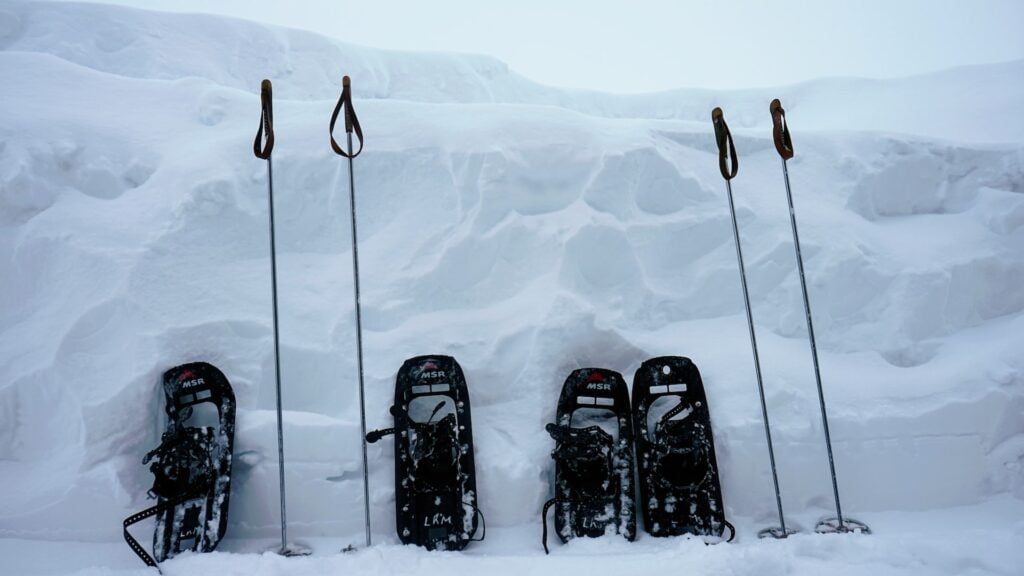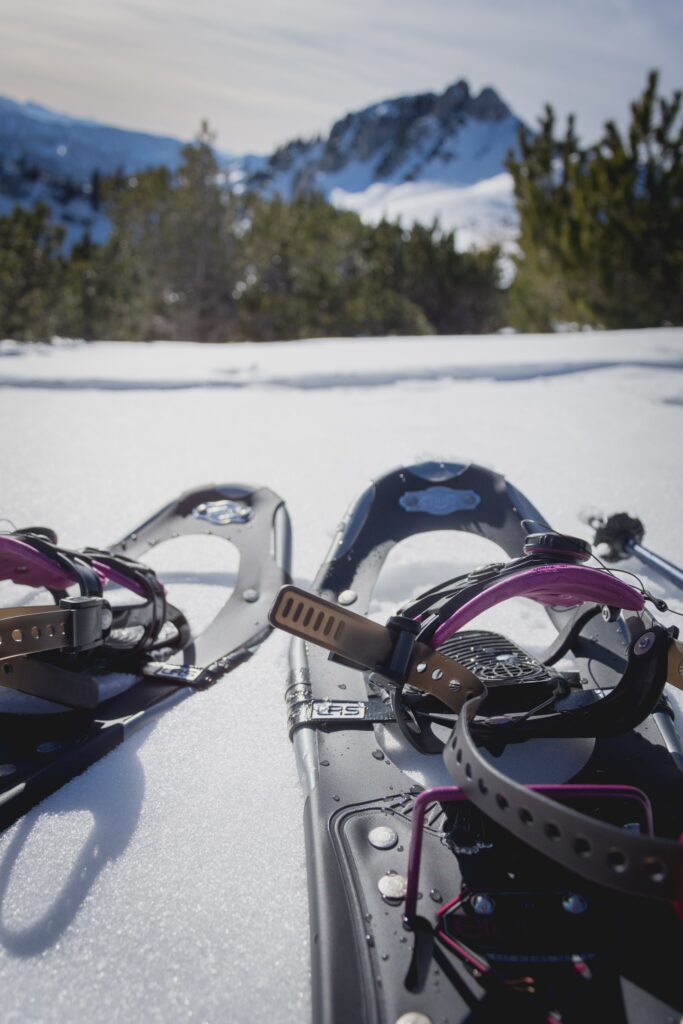Table of Contents
Snowshoes are a type of footwear that are designed to be used in snowy and icy conditions. They are typically made from wood or plastic and feature a large, flat surface area that distributes the weight of the wearer over a larger area, preventing them from sinking into the snow.
The earliest known snowshoes were used by indigenous people in North America, who crafted them from bentwood and animal hides. These early snowshoes were designed to be as light as possible, as the indigenous people needed to move quickly and silently through the forest in order to hunt and gather food.
As the technology for making snowshoes improved, they began to be used for a variety of activities, including hiking, skiing, and mountaineering. Modern snowshoes are made from a variety of materials, including aluminum, plastic, and composite materials. They also come in a variety of sizes and styles, with different designs for different types of terrain and activities.
Snowshoeing is a popular winter sport and is a great way to enjoy the outdoors during the colder months. It is also a low-impact form of exercise that is easy on the joints and can help to improve cardiovascular fitness. For those who live in areas with heavy snowfall, snowshoes can also be an essential tool for getting around during the winter.
What kind of snowshoes should I buy?
When choosing a pair of snowshoes, there are several factors to consider, including the type of terrain you will be using them on, the level of activity you plan to engage in, and your overall fitness level.
First, consider the terrain you will be using the snowshoes on. If you will be primarily using them on groomed trails or in flat, open areas, a traditional, rectangular snowshoe with a smaller surface area will work well. If you will be traversing more rugged, hilly, or off-trail terrain, a larger, more aggressive snowshoe with a tapered tail and a more aggressive crampon system will be better suited for your needs.
Next, consider the level of activity you plan to engage in. If you will be doing mostly casual walking or hiking, a smaller snowshoe with a more moderate crampon system will be fine. If you plan to do more strenuous activities such as running or backcountry touring, a larger snowshoe with a more aggressive crampon system will be better suited for your needs.
Finally, consider your overall fitness level. If you are relatively fit and have a good level of cardiovascular fitness, you may be able to handle a larger, more aggressive snowshoe. If you are not as fit, or if you have any joint or mobility issues, a smaller, more moderate snowshoe will be more appropriate.
Additionally, it is good to check the weight of the snowshoe and the weight limit it can hold. It also important to look for the bindings, that should be easy to use, comfortable, and adjustable.
Also, when choosing a pair of snowshoes, you should consider the terrain you will be using them on, the level of activity you plan to engage in, and your overall fitness level. Look for the weight, the weight limit it can hold, and the bindings should be easy to use, comfortable, and adjustable. It is also recommended to try different models and types of snowshoes before making a final decision.
Know Where You Plan to Go—Snowshoe Type by Terrain
The type of terrain you plan to use your snowshoes on will greatly affect the type of snowshoe you should choose. Each type of terrain has its own unique challenges and demands, and different types of snowshoes are better suited for different types of terrain.
Flat, groomed trails: For flat, groomed trails, a traditional, rectangular snowshoe with a smaller surface area will work well. This type of snowshoe is great for casual hiking and walking, and is also suitable for beginners.
Hilly or Off-Trail Terrain: If you plan to use your snowshoes on hilly or off-trail terrain, a larger, more aggressive snowshoe with a tapered tail and a more aggressive crampon system will be better suited for your needs. These snowshoes are designed for more strenuous activities such as backcountry touring and mountaineering, and are generally more durable and stable than traditional snowshoes.
Deep Snow: If you plan to be in deep snow, it is recommended to use snowshoes with a wider and flatter surface area, that will help distribute your weight more evenly and prevent you from sinking in the snow.
Backcountry: If you plan to be touring in the backcountry, a more aggressive snowshoe with a tapered tail and a more aggressive crampon system will be better suited for your needs. These snowshoes are designed for more strenuous activities such as backcountry touring and mountaineering, and are generally more durable and stable than traditional snowshoes.
It’s also worth noting that it is always a good idea to check the snowshoe’s weight limit and the weight of the snowshoe, especially if you plan to be carrying a heavy backpack or other gear.
At last, the type of terrain you plan to use your snowshoes on will greatly affect the type of snowshoe you should choose. For flat, groomed trails, a traditional, rectangular snowshoe with a smaller surface area will work well. For hilly or off-trail terrain, a larger, more aggressive snowshoe with a tapered tail and a more aggressive crampon system will be better suited for your needs. For deep snow, it is recommended to use snowshoes with a wider and flatter surface area. For backcountry, a more aggressive snowshoe with a tapered tail and a more aggressive crampon system will be better suited. It is always recommended to check the snowshoe’s weight limit and the weight of the snowshoe.
Snowshoe Sizing
When it comes to sizing snowshoes, there are a few key factors to consider: your weight, the type of terrain you plan to use them on, and the level of activity you plan to engage in.
Weight: The most important factor to consider when choosing the right size snowshoe is your weight. Snowshoes are designed to support a certain amount of weight, and choosing a snowshoe that is too small for your weight can lead to unstable and dangerous conditions. Be sure to check the weight limit of the snowshoes you are considering, and choose a pair that can support your weight.
Terrain: The type of terrain you plan to use your snowshoes on will also affect the size you should choose. For example, if you plan to use your snowshoes on flat, groomed trails, a smaller, more traditional snowshoe will work well. If you plan to use them on hilly or off-trail terrain, a larger, more aggressive snowshoe with a tapered tail will be better suited for your needs.
Activity Level: The level of activity you plan to engage in will also affect the size of snowshoe you should choose. If you plan to do mostly casual walking or hiking, a smaller snowshoe with a more moderate crampon system will be fine. If you plan to do more strenuous activities such as running or backcountry touring, a larger snowshoe with a more aggressive crampon system will be better suited for your needs.
It’s also worth noting that many snowshoe manufacturers provide a sizing chart to help you choose the right size for your weight and activity level. It is always a good idea to consult this chart before making a final decision.
Understanding Snowshoe Materials
Snowshoes are typically made from a variety of materials, each with its own unique set of benefits and drawbacks. The most common materials used in the construction of snowshoes include:
Aluminum: Aluminum is a lightweight and durable material that is often used in the construction of snowshoe frames. It is resistant to rust and corrosion and can provide a stable platform for the user.
Plastic: Plastic is a lightweight and inexpensive material that is often used in the construction of snowshoe decks. It is durable and easy to mold, making it a popular choice for entry-level snowshoes.
Composite Materials: Snowshoes can also be made from composite materials such as carbon fiber, which is a lightweight and strong material that is often used in high-end snowshoes.
Wood: Wood is a traditional material that has been used in the construction of snowshoes for centuries. It is a durable and lightweight material that can provide a natural look and feel to a snowshoe.
Crampon: The crampon is the metal or plastic teeth on the bottom of the snowshoe that help grip the snow. They are usually made of steel or aluminum and are designed to provide traction on various types of terrain.
Bindings: The bindings are the straps or mechanisms that hold your foot securely to the snowshoe. They can be made of nylon, leather, or other materials, and are designed to be easy to use and adjustable to different types of footwear.
In summary, Snowshoes are made of different materials, each with its own set of benefits and drawbacks. Aluminum, Plastic, Composite Materials, and Wood are the most common materials used in the construction of snowshoe frames. Crampons and Bindings are the other important parts that are usually made of steel, aluminum, nylon, leather or other materials that are designed to provide traction and keep your foot securely to the snowshoe.
Understanding Snowshoe Traction and Climbing Features
Snowshoes are designed to provide traction and support on various types of terrain, and the traction and climbing features of a snowshoe will vary depending on the intended use of the snowshoe.
Crampons: The crampons are the metal or plastic teeth on the bottom of the snowshoe that helps grip the snow. They are usually made of steel or aluminum and are designed to provide traction on various types of terrain. The number and placement of crampons can vary depending on the intended use of the snowshoe. For example, a snowshoe designed for backcountry touring will typically have more aggressive crampons than a snowshoe designed for casual walking or hiking.
Climbing Bars: Climbing bars are metal or plastic bars that are located near the toe of the snowshoe. They are designed to provide additional support when climbing steep terrain and can help prevent the snowshoe from slipping backward. Climbing bars are typically found on more aggressive or backcountry-oriented snowshoes.
Heel Lifts: Heel lifts are an adjustable feature that allows the user to raise the heel of the snowshoe, which can make it easier to climb steep terrain. They are typically found on snowshoes that are designed for backcountry touring and mountaineering.
Torsion Deck: Some snowshoes have a torsion deck that can flex and adjust to the terrain, this allows the snowshoe to follow the natural movement of the foot and can provide better traction.
Conclusion
In summary, Snowshoes are a type of footwear that is designed to be used in snowy and icy conditions, which are typically made from wood or plastic and feature a large, flat surface area that distributes the weight of the wearer over a larger area, preventing them from sinking into the snow.
They have been used for centuries by indigenous people for hunting and gathering food, and now are widely used for various activities and sports, and also as an essential tool for getting around during the winter.
When sizing snowshoes, the most important factor to consider is your weight, then the type of terrain you plan to use them on and the level of activity you plan to engage in. Always check the weight limit of the snowshoe and consult the sizing chart provided by the manufacturer.


